double loops
last updated 3 May 2022
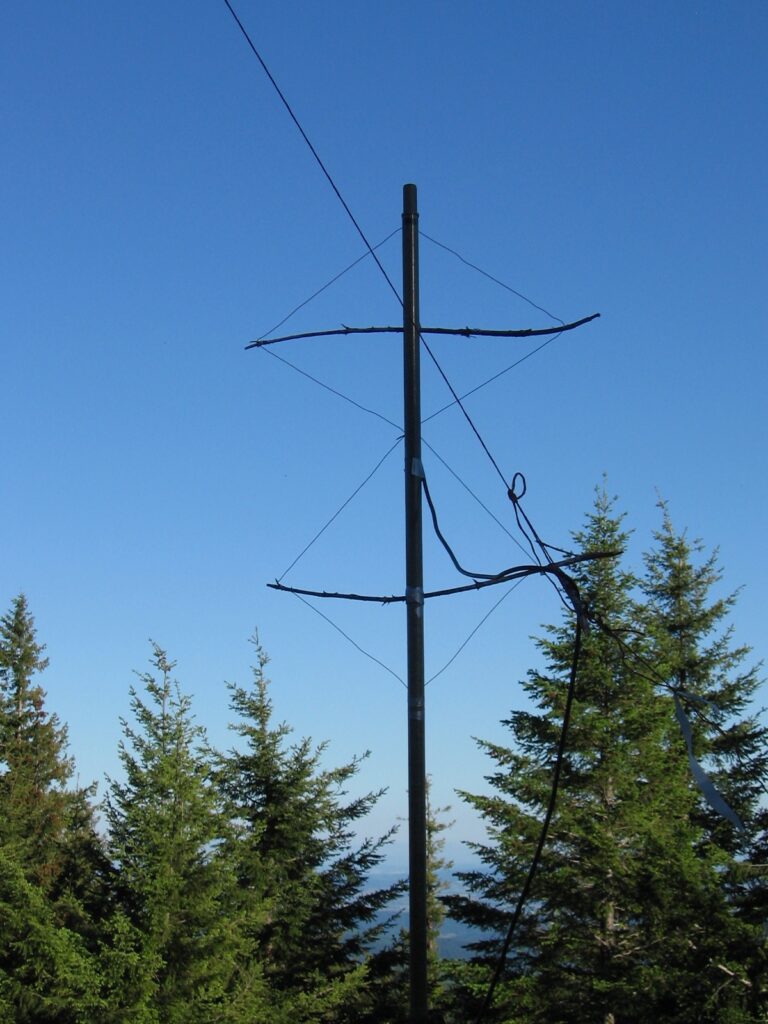
Double loops (and longer combinations) are a form of broadside gain antenna, created by using two loops in a single structure. There are many different forms.
These antennas can be used in a vertical stack for horizontal polarization (as shown here) at upper HF when sufficient height is available, and for VHF. They are sometimes used on their side for vertical polarization on the lower HF bands, where they can provide a more directive pattern, or horizontally for NVIS operation.
Gain is modest (a maximum of about 3 dB over a dipole at the same average height), and the shapes can be adjusted for convenient feedpoint impedances, as with full wave loops.
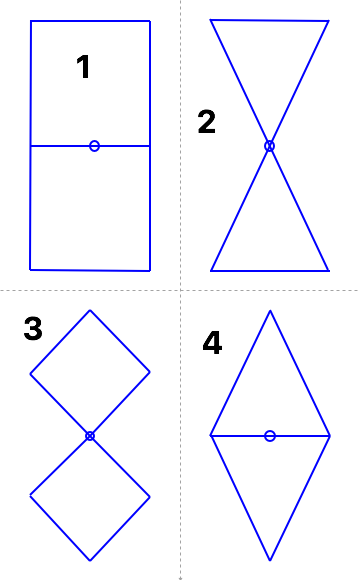
Common shapes for double loops:
1: double rectangle
2: double delta
3: double diamond
4: single diamond
Each of these basic shapes may be implemented in different ways. In general, the taller and skinnier the antenna (up to a point), the higher the gain, the lower the feedpoint impedance, and the narrower the SWR bandwidth. But there will be other variations due to how they are built and fed that can have a significant impact.
double rectangle
Let’s start with the double rectangle, as that may be the easiest to understand.
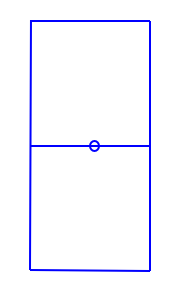
This is basically two rectangular loops connected to a common feedpoint, with one side in common between the two loops. When the loops are close to one wavelength each, and the feedpoint is in the center of the middle wire, then the currents in all 3 horizontal wires are in phase, and radiation is horizontally polarized. The vertically polarized radiation from the two vertical wires mostly cancels itself out. The 3 stacked horizontal radiators tend to compress the vertical beamwidth and reduce lobes at high angles, providing useful gain without narrowing the horizontal beamwidth of the antenna. When fed in this manner, the center wire has about twice the current as the top and bottom wires.
The double rectangle can also be fed in the center of the bottom wire, reducing the required feedline length. This actually increases the gain slightly, but also approximately doubles the feedpoint impedance due to the difference in the relative currents in the three wires. The SWR bandwidth remains unchanged.
The double rectangle is particularly useful for narrow arrays hanging from a top spreader, as it is the narrowest antenna of the group.
The double rectangle can also be built using two full-wave loops of wire, with the two wires running parallel for the center element.
Yet another method is to make the entire structure with one length of wire:
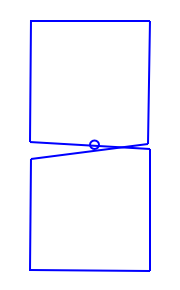
Again, the antenna can be fed either in the center wire or in the bottom. However, now the two loops are in series, rather than in parallel, and that increases the feedpoint impedance. In this case, we still have two wires in the middle, so about twice the current in the center than in the top and bottom wires, which decreases the gain slightly.
We can get around that by reducing it to a single wire 3/2 wavelengths long:
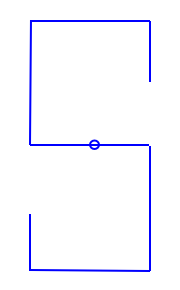
This is called a “Bruce Array” (although Edmond Bruce would rather be remembered for inventing the rhombic antenna), and the previous antenna is sometimes called a “folded Bruce”. Either can be extended to additional bays, although we don’t address that here.
Although it is no longer a loop, there is only one wire in the center, resulting in more equal currents in the 3 horizontal wires. Again, it can be fed at the bottom or the center.
These same variations: feeding it in the center or an end wire, and connecting the two loops in parallel or in series, can generally be applied to the other shapes in this family as well, although there will be some exceptions.
double delta
The double delta has longer top and bottom elements for the same overall height, so it is less convenient to hang from a single top spreader, but it may be easier to build, especially in the folded form, where it is simply a loop of wire connected to the feedline. (The antenna requires a “twist” in the middle, where the wires cross without connecting, for it to work properly with bottom feed.) This shape often would be my first choice when supports permit.
double diamond
The double diamond is similar to the double delta, but more convenient to hang off a single support due to the angled top wire. It needs longer spreaders to hold out the side corners than for a double rectangle, however. And, because the top and bottom wires are bent, the effective spacing between them is less than for straight elements, so the gain is lower than for the rectangle or delta forms with the same vertical dimension.
single diamond
This is a double delta loop with one side in common between the two loops. Again, the bent top and bottom wires reduce the gain for the same vertical height, and this version has the lowest gain of the group by about 1 dB or so. There may be some cases, such as using an aluminum center element with wire supports from a single mast, when it is a useful shape to consider.
comparisons
To compare the different versions, I looked at the gain and SWR bandwidth for an antenna with a top height of 13m (43 ft) and a bottom height of 7m (23 ft) at 28.5 MHz. That puts the average height of the array at 1/2 wavelength, with the bottom at least half the height of the top. These are reasonable guidelines for good performance from such an array, but other combinations are possible, and may change the relative results slightly. The vertical angle of maximum radiation was 14 degrees for all antennas (since they were at the same height). The width of each array was adjusted for resonance, using nominal 2mm (AWG #12) bare copper wire.
| antenna type | gain dB | impedance ohms | 1.5 : 1 SWR bandwidth MHz |
|---|---|---|---|
| double rectangle center feed | 9.7 | 80 | 0.8 |
| double rectangle bottom feed | 9.9 | 163 | 0.8 |
| double rectangle folded Bruce bottom feed | 9.6 | 265 | 1.3 |
| double rectangle folded Bruce center feed | 9.3 | 350 | 1.5 |
| double rectangle single Bruce bottom feed | 9.9 | 160 | 1.0 |
| double rectangle single Bruce center feed | 9.9 | 167 | 1.0 |
| double delta center feed | 9.4 | 195 | 1.3 |
| double delta folded Bruce bottom feed | 9.9 | 333 | 1.6 |
| double diamond center feed | 9.2 | 158 | 2.8 |
| single diamond bottom feed | 8.7 | 245 | 1.4 |
| single diamond center feed | 8.6 | 195 | 1.3 |
The highest gain and bandwidth values are highlighted.
The 2 : 1 SWR bandwidth is about 1.7 times the listed bandwidth at 1.5 : 1 SWR. So any type with a bandwidth of 1.0 or better at 1.5 : 1 should cover the whole 10m band with under 2 : 1 SWR.
In most cases, the gain can be increased by making the antenna taller and narrower, with a lower feedpoint impedance and narrower SWR bandwidth.
practical dimensions
There are too many possible variations to provide dimensions for all of them. Instead, I’ve selected what I think are the most likely versions with standard feedpoint impedances. These are all for 10m (nominal resonance at 28.5 MHz), although the dimensions can be scaled for other bands. Generally I’ve placed the center of the antenna at 10m (33 feet) above the ground, except for versions over 8m (26 feet) high, where the bottom of the antenna would be too close to the ground.
double rectangles
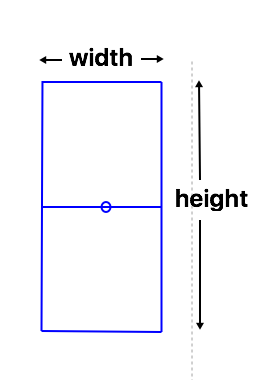
Double rectangles are defined by the width and height of the antenna. The feedpoint may be in either the center or bottom wire.
| antenna type | impedance ohms | height m ( feet ) | width m ( feet ) | gain dBi |
|---|---|---|---|---|
| double rectangle center feed | 50 | 6.6 ( 21.65 ) | 1.83 ( 6.0 ) | 10.0 |
| double rectangle bottom feed | 50 | 7.9 ( 25.9 ) | 1.21 ( 4.0 ) | 11.0 |
| double rectangle bottom feed | 112 | 6.72 ( 22.0 ) | 1.78 ( 5.84 ) | 10.4 |
| Bruce rectangle bottom feed | 112 | 6.88 ( 22.5 ) | 2.08 ( 6.8 ) | 10.1 |
double folded delta loops
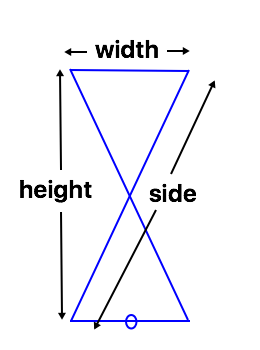
Double folded delta loops are formed from a single loop of wire with a half twist. The wires cross in the center but are not connected together.
| antenna type | impedance ohms | height m ( feet ) | width m ( feet ) | side m ( feet ) | gain dBi |
|---|---|---|---|---|---|
| double folded delta loop bottom feed | 50 | 9.0 ( 29.5 ) | 2.0 ( 6.6 ) | 9.22 ( 30.2 ) | 11.8 |
| double folded delta loop bottom feed | 112 | 8.0 ( 26.25 ) | 2.81 ( 9.25 ) | 8.48 ( 27.8 ) | 11.4 |
| double folded delta loop bottom feed | 200 | 7.0 ( 23.0 ) | 3.5 ( 11.5 ) | 7.82 ( 25.67 ) | 10.5 |
double diamonds
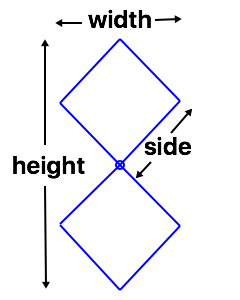
The double diamond has slightly lower gain, but wider SWR. The feedpoint is in the center, like a double rectangle with a very short center wire.
| antenna type | impedance ohms | height m ( feet ) | width m ( feet ) | side m ( feet ) | gain dBi |
|---|---|---|---|---|---|
| double diamond center feed | 50 | 9.0 ( 29.5 ) | 3.14 ( 10.3 ) | 2.7 ( 8.8 ) | 10.1 |
| double diamond center feed | 75 | 8.0 ( 26.25 ) | 3.8 ( 12.5 ) | 2.7 ( 8.8 ) | 9.8 |
| double diamond center feed | 112 | 7.0 ( 23 ) | 4.3 ( 14.1 ) | 2.7 ( 8.8 ) | 9.5 |
multiband operation of double loops
Most of the double loops fed in the center can provide useful radiation on multiple bands, at least over a 2 : 1 frequency range, if they are cut for the middle of the range and fed with open wire line. For example, a center feed double rectangle can be used for 20m through 10m if it is designed for about 20 MHz or so.
I’ve also used a folded double delta loop in the horizontal plane for dual-band NVIS operation.